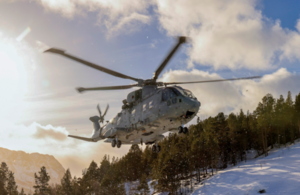Royal Navy Commando Merlin helicopters upgraded
Upgrades to the amphibious Royal Navy Commando Merlin helicopters have achieved full operating capability.

A Royal Navy Commando Merlin helicopter. MOD Crown Copyright.
Upgrades enabling Royal Navy Commando Merlin helicopters to embark in and operate from vessels anywhere in the world have achieved full operating capability (FOC). This capability is known as littoral strike, and is part of an update that supports 3 Commando Brigade.
The Merlin Life Sustainment Programme (MLSP), overseen by Defence Equipment & Support (DE&S), has now fully transitioned the AW101 MK3/Mk3a Commando Merlin helicopters to a ship-optimised, in-service capability platform designated the Mk4/Mk4a Commando Merlin.
In total, 19 Mk3 and 6 Mk3a Commando Merlins were upgraded to the Mk4/4a standard, ensuring the Commando Helicopter Force (CHF) has the capability to provide air manoeuvre support to 3 Commando Brigade Royal Marines and other UK forces anywhere in the world.
The work was overseen by DE&S - the procurement arm of the MOD - working closely with industry partner Leonardo and the Royal Navy.
The CHF - the wings of the UK Commando Force - also support the Carrier Strike Group, carry out search and rescue operations, take part in maritime security, hurricane relief support, and counter-narcotics and anti-piracy operations if required.
Following the delivery of the final aircraft conversion in 2022, DE&S has overseen retrofit after delivery activity, including integrated Mission Planning System installation and integration of type-leading Synthetic Training Equipment. The declaration of FOC confirms achievement of the Royal Navy’s requirement and system acceptance.
Key original upgrades to the aircraft include a new folding main rotor-head and folding tail, which allows two of the aircraft to fit on just one of the carriers’ aircraft lifts, and an improved defensive aid suite with a system that warns against and locates hostile laser-guided weapons. These upgrades and the latest system integrations contribute to the Merlin Mk4/4A’s reputation as the world’s most advanced amphibious battlefield helicopter.
Capt Neil Mathieson, RN Merlin DT Team Leader at DE&S, said:
The key difference between the Mk3/Mk3a and the new variant is the fact that the Mk4/Mk4a has been fully ‘ship optimised’ to allow it to in embark and more efficiently operate from Royal Navy vessels. This means the Mk4/Mk4a aircraft are globally deployable for all maritime operations.
There have been significant changes to enable this, including a new folding main rotor head and folding tail. In addition, a brand-new suite of avionics has been integrated and obsolescence removed, aligning the cockpit to the Mk2 and extending the life of the platform to 2030.
Clive Scott, SVP UK Business, Leonardo Helicopters UK, said:
Our workforce is proud to have delivered these upgrades for the Royal Navy Merlin fleet from our site in Yeovil, the home of British helicopters.
Decades of investment in the site have ensured that we have the highly-specialised design skills onshore, meaning we can modify helicopters to UK specifications and help preserve our nation’s Freedom of Action and Operational Independence.
The AW101 sets the standard for maritime operations and, as well as being one of the UK Armed Forces’ core helicopters, has been acquired by allies including Japan, Italy, and Poland.
Our export customers benefit from continuous investment in the platform, as well as their ability to interoperate with the Royal Navy.
The synthetic trainer includes two new pilot simulators, a procedures trainer and a rear crew training device employing augmented reality systems. For the first time, this is co-located at RNAS Yeovilton, with CHF providing a step-change in training capability for new aircrew and front line mission training.
Merlin is now cleared to operate from the Royal Navy’s aircraft carriers, amphibious assault ships, Type 23 frigates, Royal Fleet Auxiliary vessels and the Type 45 destroyer.
Littoral manoeuvre, sometimes termed littoral strike, describes amphibious operations using both air and surface craft that are launched from a ship to an objective. An example would be aircraft deployed from the deck of a ship flying to complete its operation (usually land-based) and then returning to the ship.
The upgrade has enabled Merlin to be a more effective component in the future conduct of littoral manoeuvre operations, allowing the CHF to generate, sustain and field a more modern aviation capability.
In addition to the operational benefits, the aircraft now share a higher commonality across all marks of Merlin, with an upgraded cockpit and avionics suite that provides efficiencies within supply chains, effective maintenance cross-platform knowledge and training, enabling further interoperability when deployed.